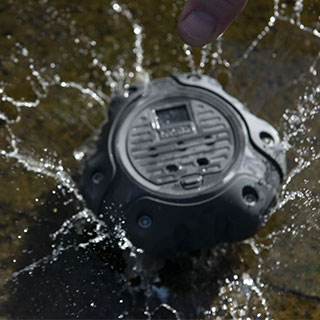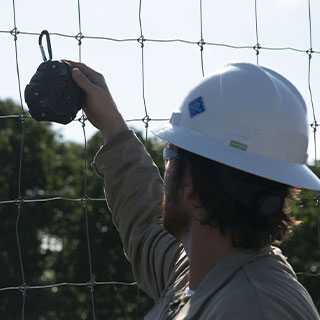Area monitoring is the use of gas detectors that merges elements from both portable and fixed gas detectors into one solution within a linked network. They are not considered personal protective equipment even though they are made to be transported from location to location. Instead, they are primarily designed to help safeguard groups of workers in a given industrial perimeter.
Area monitoring is frequently used as a temporary solution to help keep workers safe in industrial facilities where mid-term deployment occurs as well as for confined space entry and far-working locations such as oil and gas platforms.
Here is a list of 10 must-haves of an area-monitoring solution for a successful gas detection program:
Live Monitoring Capabilities
Network connectivity allows for live monitoring of sites both local and remote, from anywhere. Operators in a control room receive immediate notification when an alarm takes place; in real time, safety managers have necessary information at their fingertips. They can set a mass evacuation right from the control room, which gets shared, along with the alarm, to all connected devices.
Through this connectivity, the following occurs:
- An alarm goes off audibly and visually on the device itself when a detector identifies a hazard.
- If that device is enabled for “Shared Alarms,” every connected detector will also sound and light up for evacuation. A safety manager can set the evacuation manually from a connected cloud monitoring platform or mobile application.
- Remote alerts notify anyone connected through the cloud monitoring platform or relevant app.
Be sure the system you select can properly display alerts even if the network goes offline.
Seamless Connectivity
Your solution should alert you at the detector and remotely via computer or mobile device. Find one that simplifies system setup and connectivity.

Taking advantage of the digitization of manufacturing that is occurring in our latest industrial revolution, or Industry 4.0, the best type of gas detector connects and communicates with others in its network, even within large working perimeters, to share information, including any alarms triggered.
Digitization offers an unparalleled opportunity to gather and analyze data to streamline processes and improve safety.
When you connect your gas detection equipment to web-based grid services, you can simultaneously monitor and manage equipment at all your sites; automatically gather, analyze, and securely store data; search for and filter information; and ultimately take action to improve safety. And this can be done locally or remotely.
Look for a system that allows remote monitoring of multiple networks within a work site or across several work sites via cloud or mobile application.
Quick Network Deployment
Solutions that provide a preconfigured, ready-to-go out of the box area monitoring network requiring no special IT skills or equipment needed for setup are the most end-user–friendly ones. The easier a solution is to set up, the more likely you are to avoid introducing errors into the system.
Look for a setup that is guided, intuitive, and secure. With easy-to-follow installation tips and real-time feedback, you can be confident that you got set up right the first time with no need for complex instructions and menu selections. This saves time and eliminates the need for additional staff.
After initial setup, you also want to make sure you can quickly and easily add more detectors to your network or reconfigure the entire network and each detector as your needs evolve.
Technologically Advanced Sensors
The main job of gas detectors is to help keep workers and work sites safe. For this reason, sensor sensitivity and quick response time are fundamental. The faster a sensor responds, the safer the workers and work site should be.
Sensors should quickly and accurately detect the presence of multiple gases simultaneously and notify you when they need to be replaced so that there is not a lapse in protection and to minimize downtime. Detectors should have a long sensor life and feature other components that are built to last.
Robustness and Ruggedness
You work in tough environments. Your gas detectors need to work in them too. You need to trust that your gas detectors will run effectively and have minimal downtime, even on the toughest worksites. That's why a detector’s IP rating matters.

IP ratings stand for Ingress Protection ratings and refer to an electronic device’s ability to resist the entrance of dust, water, and other elements that may cause it to stop working.
Devices that have been tested and rank IP68 are trusted to be rugged and resist sprays and submersion.
Durable
Look for equipment that passed a 10-foot drop test and has an Ingress Protection rating of IP68 for spray, dust, and submersion. These tests are a great indication of the ruggedness—and, thus, durability—of a device.
While an ability to function well in adverse conditions is critical to safety, durability also has a direct impact on the total cost of ownership, an aspect that can’t be ignored when it comes to budgeting. Also, look for devices that have no external antennae or loose parts. That way you can transport, relocate, and hang or mount them without worrying about damaging them.
Long Battery Life, Low Maintenance
Battery capacity is key to a device’s ability to be on duty for longer hours without charging. The longer the field life of the battery, the less maintenance and attention from the safety department that is needed, so you spend more time monitoring and less time and money maintaining.
You deserve to measure run-time in months, not just days or even hours, which is all some gas detectors’ batteries last. Look for a device offering 60 days of battery life and notifications when batteries are nearing the end of their life so you can respond proactively to minimize downtime.
Coverage for a Wide Range of Applications
In any high-risk area where a gas hazard might occur, including industrial facilities where mid-term deployment takes place, area monitoring is a temporary solution for helping to ensure workers and work sites are as safe as possible. Whether used in confined spaces, along fence lines, or in far-working locations like oil and gas platforms, the ideal product is equally effective in and designed to withstand the unique challenges of each environment. This is why durability matters.
What’s more, the network scalability is also important so that the equipment can adapt to the size, scale, and location of any job. Whether onsite or remote, you want a solution that will work and get the alert out in case of an emergency.
Easy Mounting
Because gas detectors are portable and need to go where you go, they should be quick and easy to mount and relocate as needed. Choose one that is durable enough to transport yet not too cumbersome to carry around and mount or hang wherever you need it.

A good option is a combination of a 50-pound force magnet and a built-in D-ring for hanging, which facilitates installation in any part of an industrial facility as well as portability.
Performance You Can Trust
You should not only look for durable gas detectors that feature the latest and greatest technology when it comes to sensor usage and battery life, seamless connectivity, and ease of use but also partner with a manufacturer that can back up its offerings with an excellent track record of safety and support.
Find all this in one solution. Meet MSA’s ALTAIR® io360 Gas Detector, an industry-leading area monitoring solution that operates with the simplicity of a smart home device and delivers monitoring capabilities you can truly rely on. This breakthrough solution that represents the next generation of area monitoring features a compact yet rugged design, months of battery life, intuitive installation and setup, and seamless connectivity to other work sites, and it can easily be secured anywhere within an industrial facility via 50-pound force magnet or built-in D-ring hanger.
Watch the video here and learn more about safe, easy, and smart area monitoring.
Previously Featured on MSA Safety's blog.




Talk to Us!
Leave a reply
Your email address will not be published. Required fields are marked *